
The history of Bohemian
and Czechoslovakian pottery is a quite difficult subject. The
information concerning it is often confusing and is sometimes even
conflicting.
Here, a detailed description is given of the former Czech BIHL pottery
factory, including a comprehensive overview with pictures and details of
known pieces of BIHL pottery. The former BIHL pottery factory was
situated in Ledvice (or in German: Ladowitz), in the north-western part
of the current Czech Republic in the years between 1896 and 1939.

Ledvice is a small place about 10 km south of Teplice. Teplice (or in German: Teplitz) is an industrial and cultural centre in the Podkrusnohori region, with important glass, ceramics, textile, and chemical industry. The name Teplice is derived from the Czech word “teply”, which means “hot”. Teplice is the oldest spa town in Bohemia. Teplice arose after 1160 AC, when Queen Judita founded a monastery near warm water springs. Because these springs were close to important trade routes, the Benedictine monks build a monastery in what would become Teplice. Nowadays, the most valuable possession of the city is its thermal Provridlo spring, with a temperature of 42 degrees Celsius.

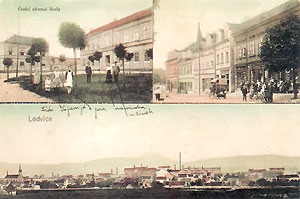
As deposits of kaolin and feldspar raw materials were discovered in Bohemia, pottery manufacturing sites sprung up around them. In the sixties of the 19th century, around 1860, there existed only three pottery factories in the Teplice area. Ten years later there were already eight pottery factories, in the eighties twelve, and at the end of the century twenty, and in the year 1905 there were nearly thirty pottery factories in the Teplice area.
Pottery, in this way, is defined as any object made of clay or other additives, molded, and dried or fired at a high temperature. Earthenware, prepared from clay, would be pottery in its simplest form, while porcelain would be pottery in its most exquisite form. Porcelain is made from fine grained white clay (kaolin), feldspar, and quartz and baked at 1400 to 1600 degrees Celsius.
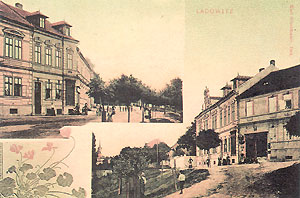
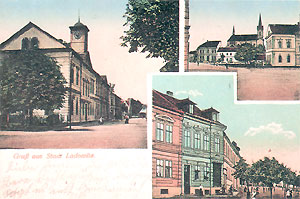
One of the first pottery factories in the Teplice area was owned by Robert Hanke. This pottery factory (Tonwarenfabrik Robert Hanke), founded in 1882, was located in Ledvice and produced a.o. all kinds of luxury vases and decorative pitchers.
Examples of Robert Hanke vases.
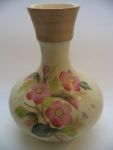


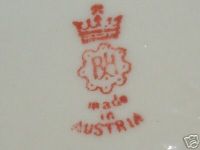




Bohemia was at that time part of Austria. Therefore, the company was registered as Robert Hanke, Austria. In the early nineties of the 19th century, production capacity of pottery increased significantly from year to year and many vases were exported within Europe and even to the United States of America.
In 1896 Gustav Bihl (see picture left), at that time general director of the Brüxer Kohlenbergbau-Gesellschaft, took over the Tonwarenfabrik Robert Hanke. The new name of the factory was Robert Hanke´s Nachfolger, Porzellan -, Fayence- und Majolikafabrik (unter G. Bihl). The factory started to produce hard-porcelain for electro-technical applications (e.g. isolators), earthenware kitchen pottery, vases with “over the glaze” and “under the glaze” decorations, and majolica.
In 1906 the company was reorganized in Porzellan- und Steingutfabrik G. Bihl & Co., GmbH. In 1918, at the end of World War I, the Paris Peace committee created a new country with the Bohemia, Moravia, and Austrian Silesia sections of the Austro-Hungarian Empire, and a northern strip of Hungary. The committee named the new country Czecho-Slovak Republic, with a hyphen. Most of the people in these areas were the Czechs (Bohemians) and Slovaks, thus the name Czecho-Slovakia. In 1920, the name Czechoslovakia (without hyphen) was introduced. From now on, the word “Czechoslovakia” appeared on pottery marks. The well-known BIHL Czechoslovakia back-stamp was introduced in this period. In addition, most Bohemian cities and towns changed names.

In 1934, the GmbH was transformed in Porzellan- und Steingutfabrik G. Bihl & Co., Aktien-Gesellschaft (AG). In 1938, Hitler’s armies stormed across the border into western Czechoslovakia (Sudeten) and then invaded the rest of Czechoslovakia. The company was forced to use the BIHL Sudetengau back-stamp. Because it turned out to be quite difficult to sell pottery with the BIHL Sudetengau back-stamp, the BIHL Germany back-stamp was introduced. German armies occupied Czechoslovakia and many factories were confiscated and forced to make supply items for the German armies. There were severe shortages of materials, coal, and other fuels, and manpower forcing most factories to cease production. Many factories were looted for parts and equipment and left in ruin while their workers were conscripted or arrested. As a consequence, the BIHL earthenware production was terminated in 1939. Up to 1944 still some hard-porcelain was produced for technical applications. In 1945, the Sudeten Germans had to leave their homes in accordance with the Potsdam agreement. As a consequence, also Alexander Bihl, at that time the general director of the BIHL Company, flew with his family to Bayern, Germany. Nowadays, no remainders are present anymore in Ledvice on the place where for several years millions of pieces of BIHL pottery was produced.